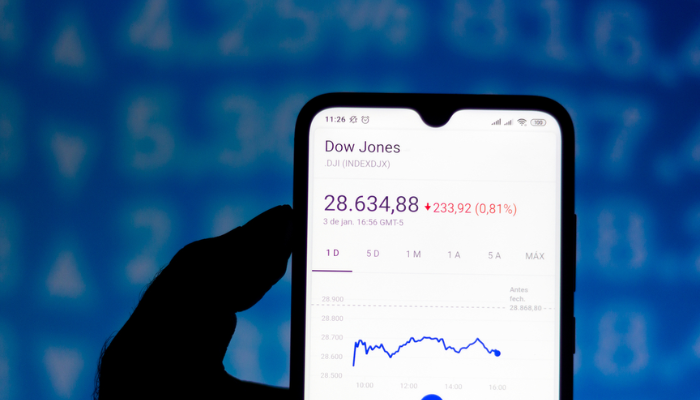
The Dow Jones Industrial Average, also known as the Dow, is one of the most popular stock market indexes, along with the S&P 500 and the Nasdaq Composite. The Dow Jones Index tracks the stock performance of 30 large blue chip companies.
Below are details of the Dow Jones Industrial Average, including the companies included in the index and how it is calculated.
Which companies are in the Dow Jones Industrial Average?
The Dow tracks 30 companies in all industries except transportation and utilities. The index dates back to 1896, when it was created by journalist Charles Dow. His business partner, Edward Jones, whose name is included in the index, was not involved in creating it. When people ask, “What did the market do today?” they usually mean the Dow or the S&P 500.
As of June 2022, the following 30 companies are included in the Dow Jones Industrial Average:
| 3M (MMM) | American Express (AXP) | Amgen (AMGN) |
| Apple (AAPL) | Boeing (BA) | Caterpillar (CAT) |
| Chevron (CVX) | Cisco Systems (CSCO) | Coca-Cola (KO) |
| Dow (DOW) | Goldman Sachs (GS) | Home Depot (HD) |
| Honeywell International (HON) | Intel (INTC) | International Business Machines (IBM) |
| Johnson & Johnson (JNJ) | JPMorgan Chase (JPM) | McDonald’s (MCD) |
| Merck & Co. (MRK) | Microsoft (MSFT) | Nike (NKE) |
| Procter & Gamble (PG) | Salesforce (CRM) | Travelers (TRV) |
| UnitedHealth Group (UNH) | Verizon Communications (VZ) | Visa (V) |
| Walgreens Boots Alliance (WBA) | Walmart (WMT) | Walt Disney (DIS) |
How are stocks included in the Dow Jones Industrial Average?
To be included in the Dow, a company must be part of the S&P 500 and cannot be part of the transportation or utilities industries (S&P Dow has other indices tracking these industries).
The S&P 500 itself has several requirements related to company market capitalization, where the stock trades, profitability, and trading volume.
Finally, the Dow Jones Industrial Average is maintained by a committee that includes three representatives from S&P Dow Jones Indices and two from The Wall Street Journal.
Since the Dow is capped at 30 companies, if another company is included in the index, it must exit the index.
The Dow Jones Industrial Average is a price-weighted index
The Dow is a price-weighted index, which means the stocks in the index are weighted according to their share price. This can lead to unique situations such as B. when a company with a smaller market capitalization is weighted more than others in the index because its share price is higher. Therefore, stock splits have a particularly strong impact on price-weighted indices.
Apple, for example, is one of the largest companies in the world based on its market capitalization of $2.3 trillion and has the largest weighting in the market capitalization-weighted S&P 500 as of June 2022. But in the Dow, based on its share price of around $140, it only ranks 18th in weight. UnitedHealth Group has the most weight in the Dow because of its share price of $513, even though its market cap is less than 25% of Apple’s.
The Dow’s price level is calculated by adding up the stock prices of companies in the index and dividing by the Dow Divider, which is periodically adjusted based on corporate actions such as dividend payments and stock splits.
Dow Jones Industrial Average vs S&P 500
The Dow Jones and S&P 500 may be the two most well-known stock market indices, but there are some key differences between the two.
- Diversification: The Dow only includes 30 large companies, while the S&P 500 includes about 500, making the latter a broader and more diverse measure of the U.S. stock market and business. For most individual investors, buying an S&P 500 index fund can be a very simple investment because of the diversification benefits it offers. Funds that track the Dow don’t offer the same benefits.
- Weighting: The S&P 500 is market capitalization-weighted, meaning the largest companies make up the bulk of the index, while the Dow is price-weighted, meaning the companies with the highest share prices will have the most weight in the index.
Bottom line
The Dow Jones Index tracks the stock performance of 30 U.S. blue-chip companies. The index is a price-weighted index that dates back to 1896 and is one of the oldest stock market indices. It’s not as diverse as broader indexes like the S&P 500, but it can still reflect the performance of the stock market and large companies.
